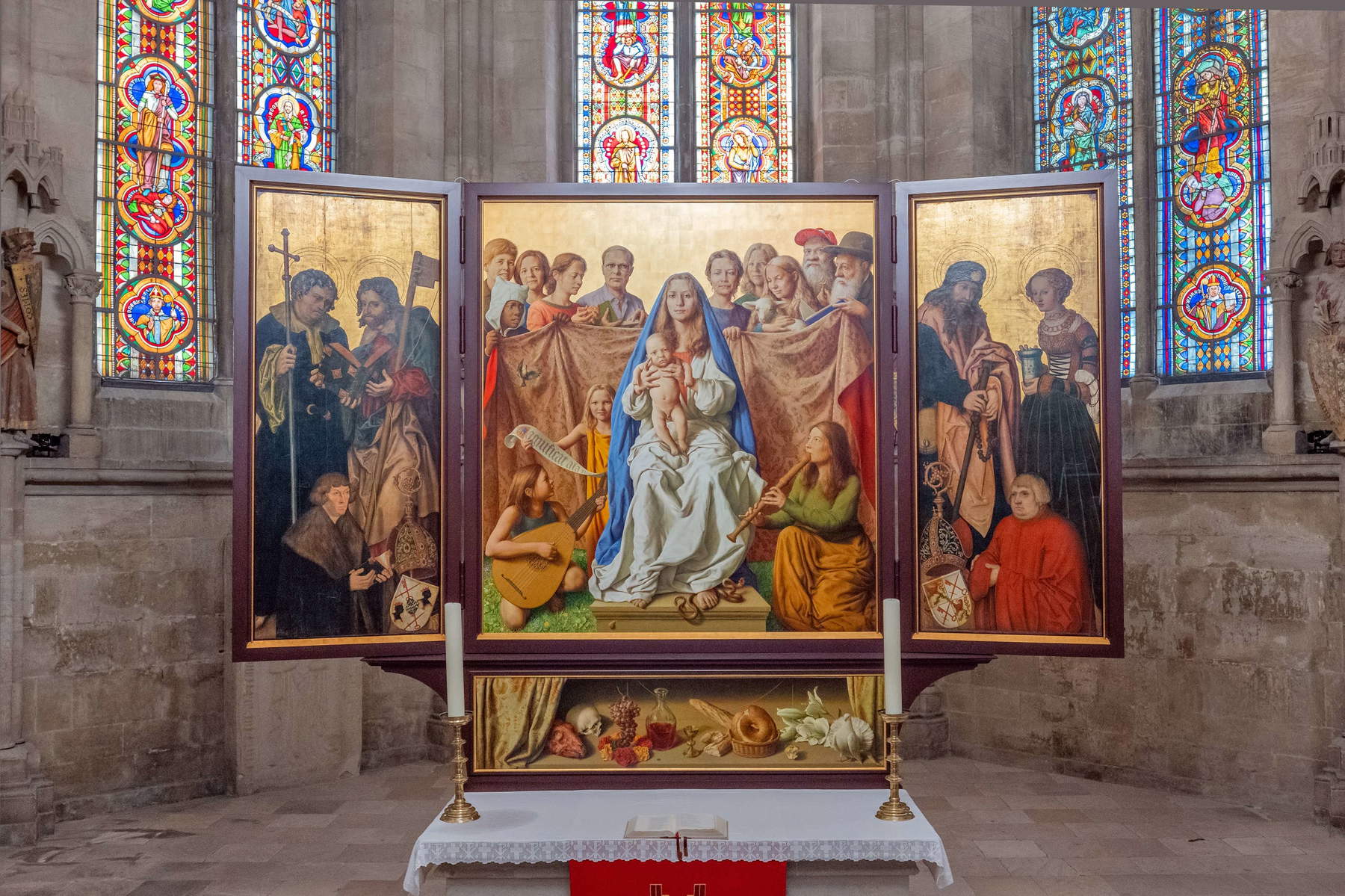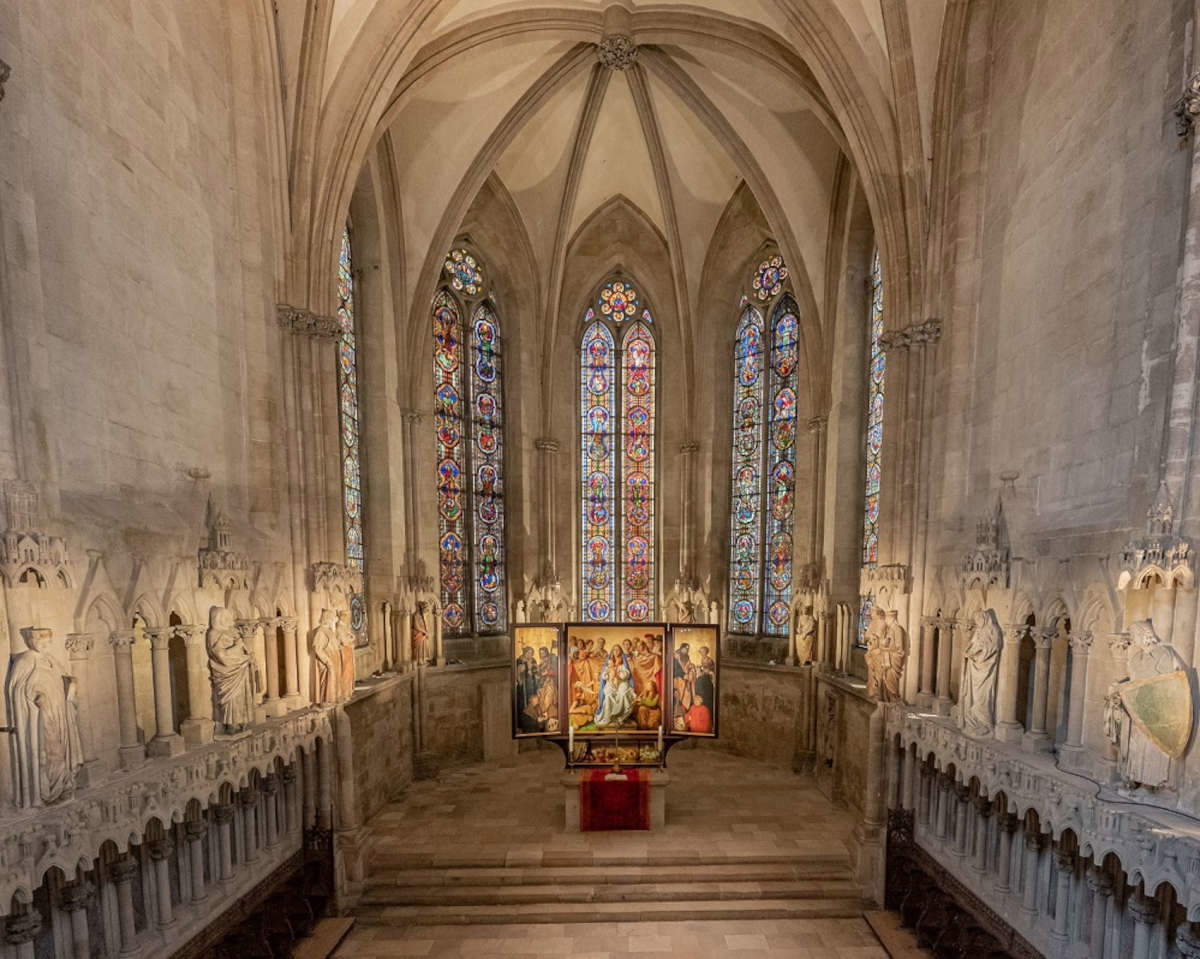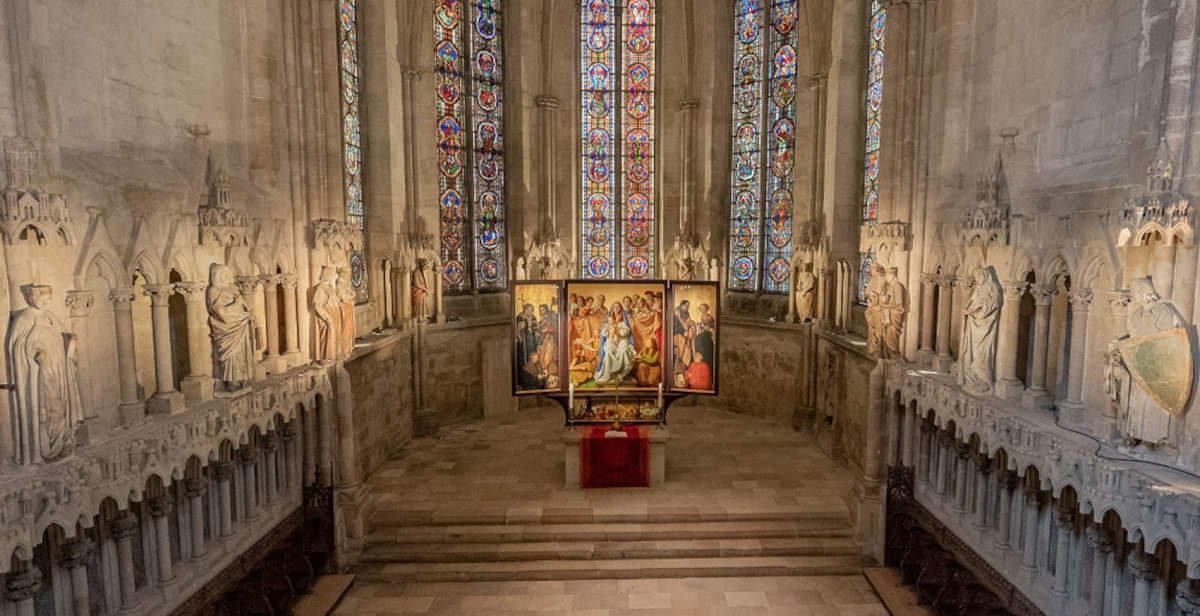Controversy is raging in Germany around the Cranach-Triegel altarpiece, the work that decorates the west choir of Naumburg Cathedral, one of the country’s most outstanding Gothic cathedrals and a UNESCO World Heritage Site since 2018. The altarpiece is so named because it is the result of the assemblage of two separate works: the side panels painted by Lucas Cranach the Elder (Kronach, 1472 - Weimar, 1553) between 1517 and 1519, and the central compartment executed by contemporary painter Michael Triegel (Erfurt, 1968) in 2022. The compartment was intended to compensate the triptych for a major gap: the central section, depicting the Virgin Mary, was in fact destroyed in 1541 in the years of iconoclasm following the Protestant Reformation. Cranach’s work, which had been placed in the western choir itself, where it remained between 1519 and 1541, was thus removed and stored elsewhere. More than five hundred years later, Triegel created the central compartment, echoing Cranach’s manner but with contemporary additions (for example, the figure of the theologian Dietrich Bonhoeffer, executed in 1945 for being an opponent of the Nazi regime, depicted wearing a red baseball cap). The placement of the work, however, is controversial because it obscures some of Naumburg Cathedral’s donor figures, the 13th-century statues depicting the benefactors who financed the construction of the sacred building, which decorate the chancel walls and are among the most interesting works not only in Naumburg Cathedral, but in all of medieval German art.
The work was installed in July 2022, but in December it was dismantled because it was taken on display in different venues: this was a move, they explained from the Vereinigte Domstifter zu Merseburg und Naumburg (the United Foundations of the Cathedrals of Merseburg and Naumburg, which manage the monument), to quiet the discussion for some time. It only returned to Naumburg Cathedral this year, and the controversy, as was to be expected, has flared up again, because on the one hand the scholarly community would like to have the altarpiece moved, while on the other hand the community of the faithful, represented by the parish (of the evangelical Christian faith), wants to keep it in the western choir.

As early as 2022, the German section of ICOMOS, the International Council on Monuments and Sites, which also advises UNESCO, intervened: the position of the ICOMOS experts was that the new altarpiece compromises the visual relationships in the western choir of Naumburg Cathedral, to the point that there had even been discussions in the past about a possible revocation of the cathedral’s World Heritage status. The state of Saxony-Anhalt then moved, requesting mediation and arbitration from UNESCO in Paris, and the organization sent two international experts to Naumburg in March 2025 to assess the work’s placement. And the response of their visit, the state itself announced in a statement, is that the Cranach-Triegel altarpiece may continue to be displayed in Naumburg Cathedral, but it will have to be relocated.
In response to the report of the two UNESCO experts, the United Foundations of Cathedrals, the Saxony-Anhalt Regional Office for the Preservation of Monuments and Archaeology, as well as representatives of the Land Chancellery and its Ministry of Culture, examined several possible locations within the cathedral. A future installation in the cathedral’s transept was then recommended as the best solution, according to a statement from the Land of Saxony-Anhalt. The space in the north transept, it says, “is particularly important because it gives the work its own dignified space within the cathedral.”
Also according to the Land statement, issued July 9, the UNESCO pronouncement “ends a years-long debate among architectural experts, archivists and historians involved in the preservation of Naumburg Cathedral regarding the original installation of Cranach’s altarpiece in the 16th century [...]. According to the conclusions now presented, the altar can expressly and permanently remain in the cathedral, but not in the western choir. International experts believe that this would seriously damage the extraordinary collection of early medieval architectural, sculptural and stained glass works, particularly the figures of the donors surrounding Uta of Naumburg. According to UNESCO, this is detrimental to the World Heritage Site and cannot be tolerated to remain as it is.”
Saxony-Anhalt Culture Minister Rainer Robra said, “The altar can remain in the cathedral and will be moved to the north transept. I am relieved that we were able to achieve a positive result for our World Heritage sites and for the citizens of Saxony-Anhalt through a solution-oriented process. I thank everyone involved for their constructive approach to this difficult issue.”
Harald Meller, Director of the Regional Office for Monument Preservation and Archaeology of Saxony-Anhalt, is also in the same vein: “The assessment of the UNESCO experts gives full reason to the monument conservators of our state. However, it is even more important to me: as experts in monument preservation - whether at the state level or at cultural foundations or international bodies - we can sometimes have divergent opinions and, as scientists, sometimes even clash bitterly; however, we always fight for the same cause: the preservation and appropriate use of our cultural heritage as a legacy for future generations. That is what matters - and we have continued to do that successfully here in Naumburg and will continue to do so.”
Foundations Director Holger Kunde said, “The Cranach-Triegel altarpiece connects 16th-century history and the present through the medium of art. In the future it will be displayed in the north transept, in dialogue with other works from various periods and with contemporary art. It has found its new home here. I am excited about the impact the altar will have in its new home. As soon as possible, we will have an altar mensa built in the north transept, in close consultation with the monument protection authorities, as we expect to complete all the work on the altar and the new stained glass windows in the eastern choir within a year.”


All over then? Nope. Getting in the way is the parish of Naumburg Cathedral, which wants to keep the Cranach-Triegel altarpiece in the west choir and accuses the scientific community of disregarding the needs of the faithful: the position received, last August 7, the support of the Evangelical Church of Central Germany (EKDM), which in turn published a note with the parish’s position. “As the community of the Naumburg Cathedral,” it reads, “we note with great concern the discussion regarding a possible transfer of the Cranach-Triegel altarpiece from the Western Choir. We expressly and strongly support the permanence of the altar in its current location. On July 2, 2022, the altar was jointly consecrated by the Protestant and Catholic bishops during an ecumenical ceremony. It was thus integrated liturgically into the space as a symbol of living faith, interfaith coexistence, and spiritual center. Its relocation would not only be a functional intervention, but a desecration of the altar and a disregard for its spiritual significance. The western chancel has been the traditional location of the altar since the Middle Ages. The Gothic high altar originally placed there was destroyed in 1541 in an iconoclastic act. The present rebuilding of an altar in this location therefore represents not only a liturgical decision, but also a conscious sign of reconciliation with history-a spiritual healing that does not suppress what was once destroyed, but rather reinterprets it with dignity.”
One of the most frequently cited arguments against placement in the western choir is the alleged interruption of the view to the figures of the donors, particularly Uta of Naumburg and Eccard II, perhaps the most famous of the twelve statues . However, according to the parish, “this justification is unfounded. A careful analysis of the directions of observation reveals that these figures direct their gaze exactly toward the liturgical center, the altar. Their spiritual and physical orientation supports the theological interpretation of the space and even gives the altar additional meaning. What some perceive as a disturbance actually turns out to be a confirmation: the figures of the donors point-even literally-to Christ. The altar thus does not contradict the spatial arrangement, but rather is in harmony with it. Moving it to the north transept, as proposed in the current debates, is unacceptable from the perspective of the parish. There, the altar lacks liturgical context and the space loses its spiritual center. The western choir, on the other hand, was and remains the place of Holy Communion, sermon and congregation: that is where the altar should be located. This effect does not escape visitors to the cathedral. Since the installation of the altar, we have seen an overwhelmingly positive response. Many say that the altar enhances the spiritual impact of the space, rather than interrupting it, and that it impressively connects the historical and contemporary experience. In this context, we emphasize the church’s right to self-determination in sacred space. Liturgical order and design are the responsibility of the congregation, not external authorities. This fundamental right applies regardless of Unesco World Heritage status.”

The parish reiterates that it never gave its consent to the transfer, thus contradicting the July 9 Land communiqué in which it was instead written that the parish had also accepted theoutcome of the Unesco experts’ report, and therefore demands the permanent retention of the consecrated altar in the western choir, the recognition of the consecration of the altar as liturgically binding, respect for ecclesiastical self-determination in sacred spaces, and the enhancement of the western choir as a place of spiritual continuity and historical responsibility. “The altar,” the statement concludes, “is where it belongs: at the center of the life of the Church, in a place where it creates liturgical, historical and spiritual significance.” For now, then, the altarpiece is not moving from the Western choir, but the dispute will probably not stop there.
 |
| Germany risks losing a World Heritage Site for... the placement of a shovel |
Warning: the translation into English of the original Italian article was created using automatic tools. We undertake to review all articles, but we do not guarantee the total absence of inaccuracies in the translation due to the program. You can find the original by clicking on the ITA button. If you find any mistake,please contact us.